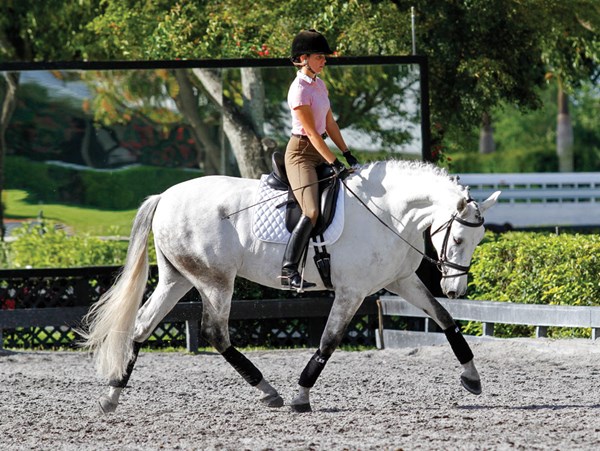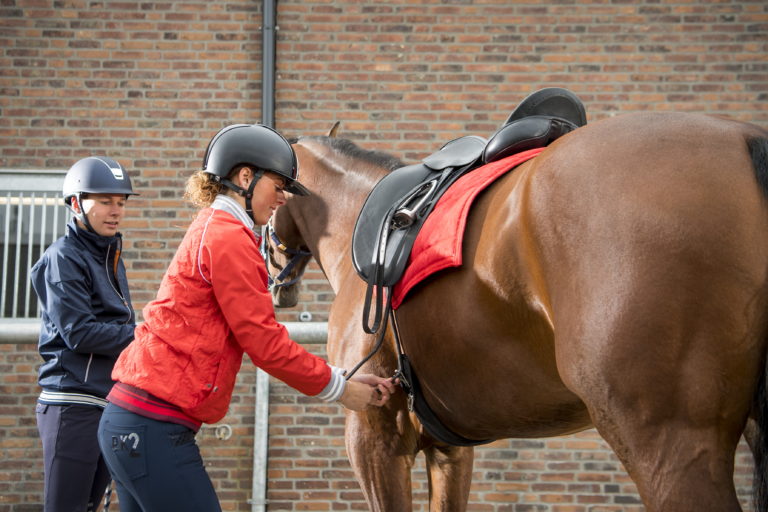Q: Could you give me some exercises to make my horse’s trot strides slower and more elastic, with more depth to the gait? I do get slowness, but I feel the elasticity isn’t there. What should I work on? —Name withheld by request
A: Before addressing the elasticity, let’s look at possible reasons why you feel the need to slow your horse’s trot. Generally, a hurried trot tempo has many sources. Most commonly these are tension, overactive driving aids or faulty balance.

Tension could be caused by factors such as reaction to environmental stimuli, fear, pain or confusion by the rider’s aids. Or you simply have a horse who is genetically hot and sensitive, tending to hurry when pressured. Once you can identify and help your horse through his source of tension, the more likely he will relax his mind, body and tempo.
With overactive driving aids, the rider hurries the horse out of his natural tempo by aggressive or unceasing driving aids. This often happens when the rider feels the horse is not in front of her leg and can cause a vicious circle: The rider feels insufficient reaction to the leg and therefore drives with every stride. The horse becomes even more dull, which perpetuates the cycle.
In this case, first make sure the horse is round and supple over his back and that you are inviting him to seek a contact out toward the bit, keeping your wrists and hands soft (see more on throughness below). Check that you are sitting in balance, with proper shoulder, hip and heel alignment, with a relaxed seat and legs. Use your legs only when asking the horse for something, such as to move off more energetically in the trot. In between, keep your aids neutral. To test, try going from a passive neutral leg to an activating leg and then be alert: You must immediately reward a good response by quickly relaxing the aids or follow up a nonresponse with a tap of the whip or bump of the leg. In other words, be clear in what you are asking for and quick to either reward or correct your horse. Your aids will become precise and more meaningful to him.
Rushing can be caused by the horse’s balance having fallen to the forehand. To help relieve the forehand, ride frequent half halts and transitions. The moment you feel the horse take a bit more weight behind, soften your hands to allow the forehand to lighten. Ride frequent transitions within gaits and between gaits. Further improve the balance by adding shoulder-in, which supples the hindquarters, creating more carrying and thus a slower tempo. Keep in mind that slowness due to inactive hindquarters is never correct.
To develop elasticity in the trot, you’ll need to address both lateral (side-to-side) suppleness and longitudinal (back-front) suppleness and frequently alternate the two throughout each ride. Elasticity can be defined as the ability or tendency to stretch or contract the musculature smoothly, giving the impression of stretchiness or springiness. I also like to think of it as looseness. Stretching long and low and performing transitions between gaits, transitions within gaits and half halts help develop longitudinal suppleness, while circles and bent lines, shoulder-in, travers/renvers and half pass improve lateral suppleness. Actually, you will find that shoulder-in, when correctly ridden, is useful in both. An example of combining the exercises is as follows. Be creative and listen to your horse’s responses as you work together.
After you have loosened your horse’s muscles and achieved a round, lifted back through careful warming up and stretching, begin in working trot. Ride energetically forward to establish the activity of the hindquarters, keeping the same tempo. Now, ask your horse to collect for a few strides—maybe six or seven—reward, and again ask him to move out. Ride several of these transitions until they happen smoothly and without resistance. Not only does this help develop longitudinal suppleness, it also strengthens your horse’s hindquarters and balance by alternating pushing and carrying power. This work also improves throughness, the ability to transfer energy from the hindquarters forward toward the bit and from the bit back to the hindquarters without any resistance, stiffening or dropping of the back.
Now, add some bending work such as voltes and serpentines, making sure your horse bends according to the line you are riding and that the shoulders or quarters do not escape in or out. Picture the horse’s spine lying directly on top of each line. Again ride a few transitions within the trot, followed by shoulder-in or leg yield. Change direction and repeat the exercises. Now add travers/renvers or half pass (according to your horse’s level of training), followed again by some forward–back transitions or transitions between gaits, such as trot–canter–trot or canter–walk–canter. For more advanced horses, transitions within the canter, such as collected to very collected and back again, are quite helpful.
Remember to give your horse frequent walk breaks and/or stretchy trot circles in between this work. Avoid riding with the same bend, in the same direction or with the same stride length for long periods of time since this can cause muscle fatigue, tension and loss of elasticity, not to mention boredom and frustration. If the horse stiffens his back or drops it entirely during the work, you’ve lost the bridge over his back, and he will likely become tense, shorten his stride or lose the supple contact. A simple remedy is to go back to rising trot and allow him to lower his neck and stretch forward and down into the contact, until you feel his back raise and swing again.
If you carefully weave these exercises into one another, you will be surprised by how much more elastic and expressive your horse’s trot becomes. Your friends may even think you got a new horse!

Sandy Hotz is an FEI 3* and USEF “S” judge. She has been actively involved in dressage for more than 30 years, enjoys training horses and students to the FEI levels and conducts clinics throughout the United States. She resides in Colorado.











